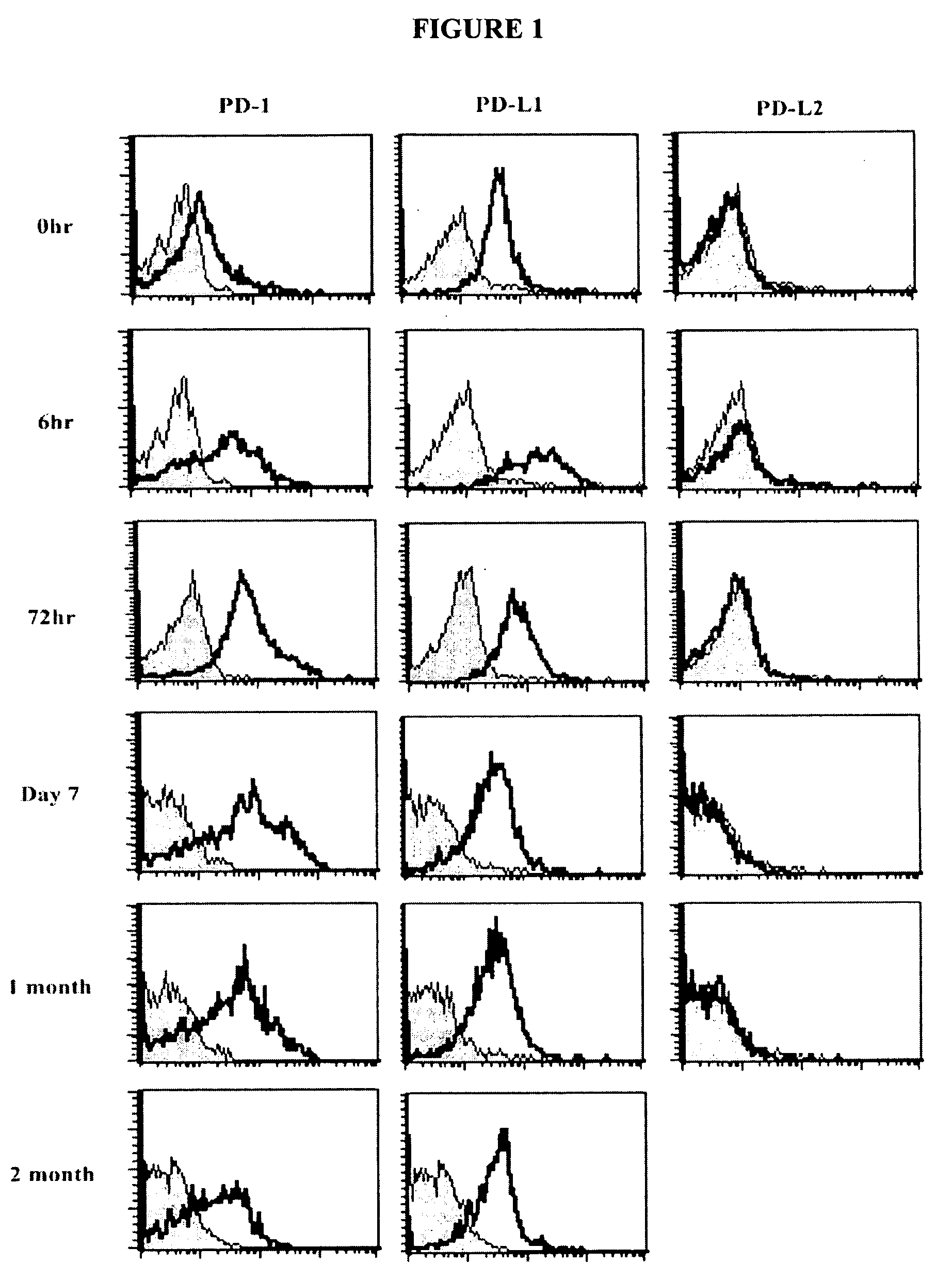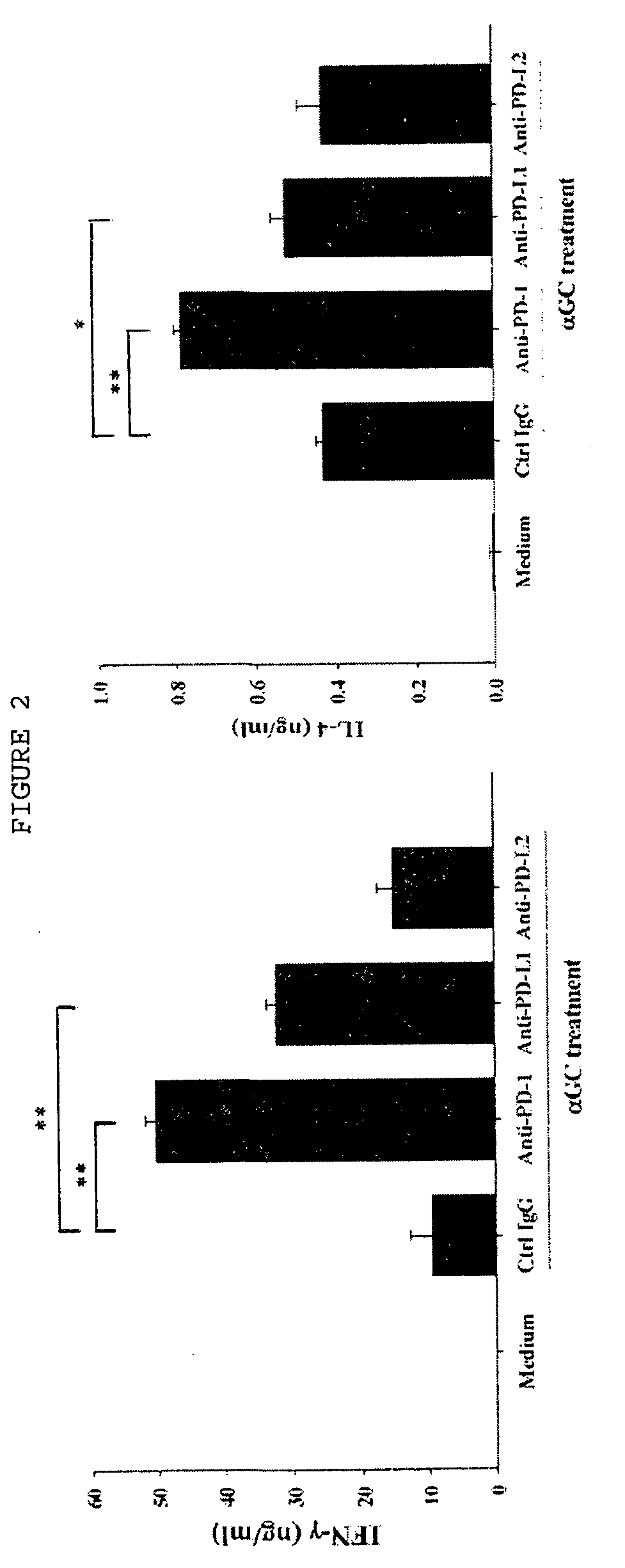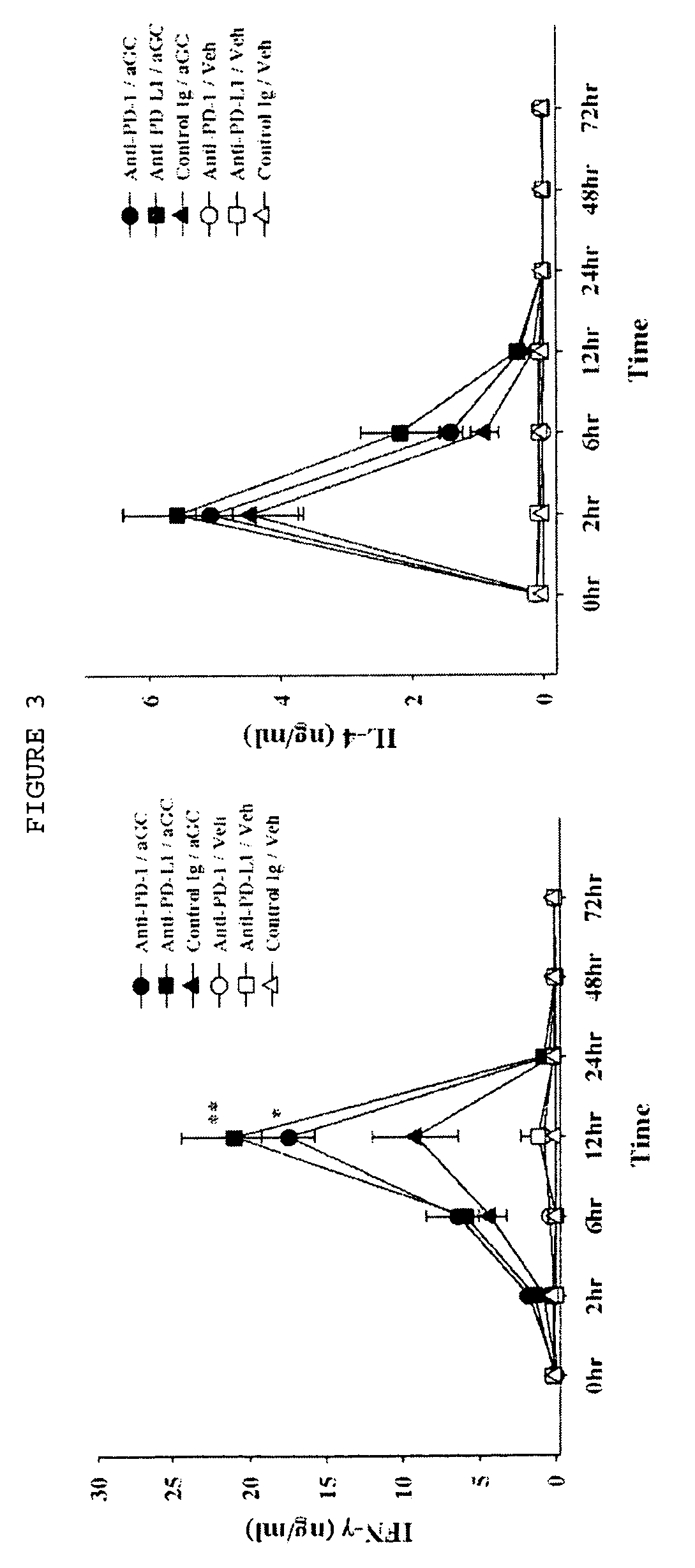Anticancer agent comprising Anti-pd-1 antibody or Anti-pd-l1 antibody
an anticancer agent and anti-pd-1 technology, applied in the field of anticancer agents, can solve the problems of inability to achieve effective anticancer effects, inability to produce effective anticancer effects, and inability to respond to inkt cells greatly, so as to achieve greater production and increase the effect of production
- Summary
- Abstract
- Description
- Claims
- Application Information
AI Technical Summary
Benefits of technology
Problems solved by technology
Method used
Image
Examples
example 1
Expression of PD-1 and PD Ligands in iNKT Cells
[0034]1. Experimental Animals
[0035]Six- to eight-week-old female C56BL / 6 mice were purchased from Orient Bio. All mice were bred and maintained in specific pathogen-free conditions.
[0036]2. Reagents and Antibodies
[0037]α-GC was dissolved in PBS containing 0.5% Tween 20. Hybridoma clones producing antibodies to mouse PD-1 (RMP1-14, rat IgG2a), PD-L1 (MIH-5, rat IgG2a), and PD-L2 (Ty25, rat IgG2a) were produced according to methods well known in the art [Yamazaki, T., H. Akiba, H. Iwai, H. Matsuda, M. Aoki, Y. Tanno, T. Shin, H. Tsuchiya, D. M. Pardoll, K. Okumura, M. Azuma, and H. Yagita. 2002. Expression of programmed death 1 ligands by murine T cells and APC. J Immunol 169:5538-5545.; Tsushima, F., H. Iwai, N. Otsuki, M. Abe, S. Hirose, T. Yamazaki, H. Akiba, H. Yagita, Y. Takahashi, K. Omura, K. Okumura, and M. Azuma. 2003. Preferential contribution of B7-H1 to programmed death-1-mediated regulation of hapten-specific allergic inflamm...
example 2
Effects of PD-1, PD-L1 and PD-L2 on iNKT Cell Activation
[0041]The following in vitro and in vivo experiments were conducted to examine the effects of PD-1, PD-L1 and PD-L2 on iNKT cell activation.
[0042]1. iNKT Cell Activation In Vitro
[0043]After being prepared from naëve C57BL / 6 mice, 5×105 spelenocytes were incubated for 3 days with 100 ng / ml of α-GC in the presence of 50 μg / ml of the control rat IgG, the anti-PD-1 mAb, the anti-PD-L1 mAb, or the anti-PD-L2 mAb. Then, the supernatants were obtained and assayed for IFN-γ and IL-4 levels by ELISA.
[0044]The results are given in FIG. 2.
[0045]Compared with control IgG treatment, as is apparent from FIG. 2, anti-PD-1 mAb significantly increased the production of IFN-γ and, to a lesser extent, IL-4. Anti-PD-L1 mAb also induced greater production of IFN-γ, but anti-PD-L2 mAb did not.
[0046]2. iNKT Cell Activation in Vivo
[0047]C57BL / 6 mice was injected with 200 μg of the control rat IgG, the anti-PD-1 mAb, the anti-PD-L1 mAb or the anti-PD-L...
example 3
Effects of Blockage of PD-1 / PD-L1 Interaction on Responsiveness of Anergic iNKT Cells
[0052]The following in vitro and in vivo experiments were performed in order to examine whether the blockage of PD-1 / PD-L 1 interaction reverses iNKT cell anergy.
[0053]1. Recovery of Responsiveness of Anergic iNKT Cells in Vitro
[0054]The α-GC-induced unresponsiveness of iNKT cells was detected as early as 3 days after primary stimulation and observed to persist until 7˜30 days after α-GC stimulation. Thus, C57BL / 6 mice were injected with 2 μg of α-GC to induce iNKT cell anergy. One week and one month later, splenocytes were isolated from the mice and 5×105 cells were incubated for 3 days with 100 ng / ml of α-GC in the presence of 50 μg / ml of the control rat IgG, the anti-PD-1 mAb, the anti-PD-L1 mAb, or the anti-PD-L2 mAb. Also, splenocytes isolated from the mice were incubated for 3 days with 10 ng / ml of α-GC without mAb, and these were represented by ‘activation’. The supernatants were then assayed...
PUM
| Property | Measurement | Unit |
|---|---|---|
| weight | aaaaa | aaaaa |
| weight | aaaaa | aaaaa |
| volume | aaaaa | aaaaa |
Abstract
Description
Claims
Application Information
 Login to View More
Login to View More - R&D
- Intellectual Property
- Life Sciences
- Materials
- Tech Scout
- Unparalleled Data Quality
- Higher Quality Content
- 60% Fewer Hallucinations
Browse by: Latest US Patents, China's latest patents, Technical Efficacy Thesaurus, Application Domain, Technology Topic, Popular Technical Reports.
© 2025 PatSnap. All rights reserved.Legal|Privacy policy|Modern Slavery Act Transparency Statement|Sitemap|About US| Contact US: help@patsnap.com



